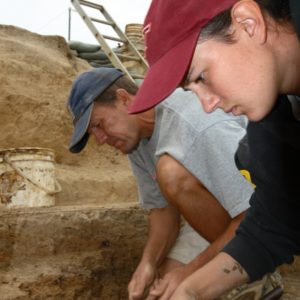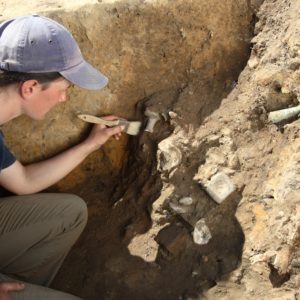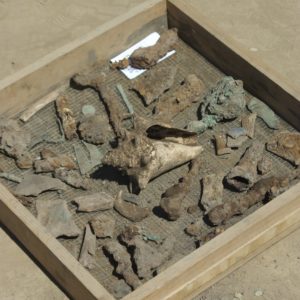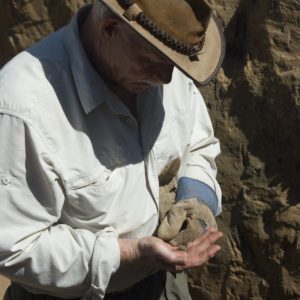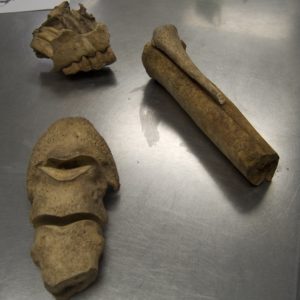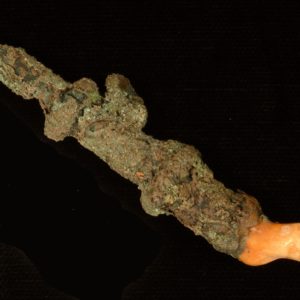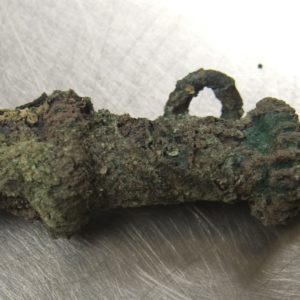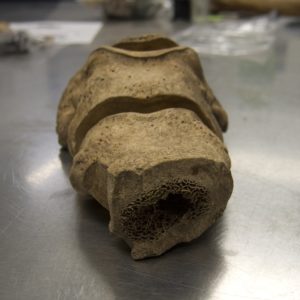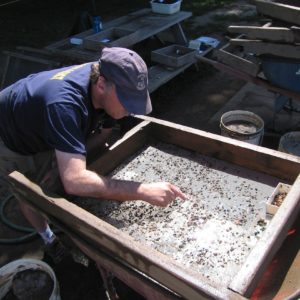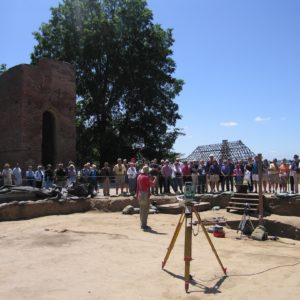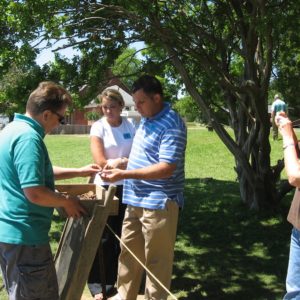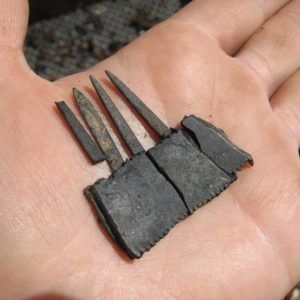At the center of James Fort, the Jamestown Rediscovery team is troweling away at a very early underground feature. Almost certainly a well, the feature has yielded thousands of artifacts so far. Recent finds include the firing mechanism for a snaphaunce musket, a piece of jewelry—possibly an earring, the match for which was found in August 2006—a Bartmann jug, a Queen conch shell, and butchered horse bones which may be evidence of the colonists’ desperate hunger during the Starving Time winter of 1609-1610. The archaeologists are just under five feet deep into the feature and will be installing a steel casing to protect themselves before proceeding deeper.
Having excavated and studied several other wells both within and outside the fort boundaries, the archaeologists of the Jamestown Rediscovery team are more and more certain that the subterranean feature that they’re currently excavating is also a well. Its shape, depth, and the way that the soil layers all sink in toward the center of the feature convince the archaeologists that they’re dealing with a well. Wells have proven to be very important to the Jamestown Rediscovery project because the colonists used them as trash pits once their water turned sour; 400 years have turned this trash—and objects accidentally dropped into the well—into priceless objects that can tell us much about the colonists and the state of the colony during the few years the well was in use. Visitors to Historic Jamestowne can watch the well excavations live and get a closer look via a live feed sent to the Jamestown Memorial Church just feet away.
The feature is full of artifacts including a huge amount of animal bones and objects made both by Europeans and Virginia Indians. Of particular interest are several horse bones that show evidence of butchering. On one leg bone there is a neat cut severing the lower leg and hoof from the rest of the leg. Horses were not typically eaten by the English, so this could be evidence of desperate times. If this feature turns out to be the fort’s first well, then it existed during the Starving Time winter of 1609-1610 when there are records of the colonists eating things such as horses and shoe leather in order to survive. Hordes of oyster shells and fish bones from the colonists’ meals have also been found in the feature. A burnt piece of corn cob was also recently discovered. A nearly wholly-intact Queen conch shell found in the feature is not native to the Chesapeake region and probably was picked up in Bermuda or the Caribbean.
Native American pottery sherds, shell beads, and stone flakes continue to be found in the feature as do bandolier cylinders, or gunpowder containers worn by the colonists on a belt (bandolier) slung over one shoulder. The firing mechanism for a snaphaunce musket was recently found, albeit heavily rusted and almost unrecognizable. Conservation techniques such as electrolysis and air abrasion should go a long way in restoring some semblance of its original appearance. A piece of jewelry just excavated from the feature appears to be a member of at least a two-piece set. The object consists of a glass heart-shaped bead with a green-stained bone bead above it. A more complete, nearly-identical version was found in August 2006 in a pit used for shelter in the earliest days of the fort. Perhaps the most interesting artifact to be discovered in the past week is a child’s copper alloy whistle. On one end of the whistle is a piece of coral used as a teething stick. A loop on the whistle was used to attach it to a ribbon or chain to hang around the baby’s neck. The whistle is heavily corroded and will soon be subjected to the conservation process.
related images
- Mary Anna and Don in the pit
- Excavating in an area thick with artifacts
- The heart-shaped jewelry piece in situ
- Finds from May 21
- William Kelso examines an Irish penny found in the feature
- Archaeologists Mary Anna Richardson and William Kelso conduct excavations in the subterranean feature
- Horse bones. Notice the neatly-severed lower leg at the bottom left.
- Child’s teething whistle
- Baby whistle and teething stick
- Horse bones of the lower leg notice the neat cut made by the colonists.
- A tray of recent finds
- Archaeologist Danny Smith and Trustee Eric Thorpe at work in the feature
- A burnt section of corn cob
- Archaeologist Chuck Durfor searches for tiny artifacts from the fill
- Archaeologist Dan Smith screens for artifacts in the fill excavated from the subterranean feature
- Archaeologist Danny Schmidt gives a tour of the fort excavations
- Trustee Eric Thorpe shares some of the recent finds with visitors.
- Queen conch shell
- A comb found in the feature. Missing are closely spaced teeth opposite the large teeth for combing out lice eggs.



